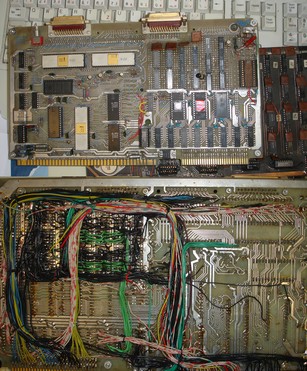Work
My current research is described on a page of the laboratory. Here I want to share with a visitor memories of past decades when the research was made under quite difficult contitions. By reading this you may more appreciate ammenities of our days...
I graduated in physical chemistry at the Charles University (Prague) and I joint the Polarographic Institute in 1963. At that time the electrochemical experiments were performed on a polarographs featuring a motor-driven potentiometer and a string mirror galvanometer, which reflected a light spot on a film casette.
A milestone of my life was a postdoc position with Bob de Levie at the Georgetown University (1968-70). He introduced me to the solid-state instrumentation. After my return to Czechoslovakia I begun a painfull work to set-up a more modern electrochemical instrumentation. Within less than a year my home-made potentiostats and equally home-made lock-in amplifier started to produce results. It was probably the first automatic admittance instrument in the East block. This increased my reputation and fostered foreigners for cooperation. At that time I was deprived to lead a group, which lasted till 1989.
 Any type of automatic data acquisition
was out of question because critical components were embargoed to the soviet-controlled countries.
In the second half of 1970's the import of 8-bit CPUs was exempt from restrictions.
This enticed me to the digital instrumentation world. With help of friendly colleagues-electronitians
from the Development laboratories I finally succeeded to construct an 8-bit computer
based on Intel8080 CPU and an arithmetic processor. That machine was equipped with
a memory of 14 kbytes. The first ROM available on the Czech market had size of 32 bytes!
Software was developped without any assembler compilers. OpCodes were
read from tables and hex codes were typed to the memory. Please stop laughing. That instrument was capable to perform
FFT impedance measurements and its operation produced quite a number of electrochemical publications.
System worked from 1979-89. Its retired torso is shown on a photo.
Any type of automatic data acquisition
was out of question because critical components were embargoed to the soviet-controlled countries.
In the second half of 1970's the import of 8-bit CPUs was exempt from restrictions.
This enticed me to the digital instrumentation world. With help of friendly colleagues-electronitians
from the Development laboratories I finally succeeded to construct an 8-bit computer
based on Intel8080 CPU and an arithmetic processor. That machine was equipped with
a memory of 14 kbytes. The first ROM available on the Czech market had size of 32 bytes!
Software was developped without any assembler compilers. OpCodes were
read from tables and hex codes were typed to the memory. Please stop laughing. That instrument was capable to perform
FFT impedance measurements and its operation produced quite a number of electrochemical publications.
System worked from 1979-89. Its retired torso is shown on a photo. Replacement by a more powerfull computer with Zilog Z80 was made in 1989. Experiments in real time were programmed in Pascal. Within two years PC 486 came to the stage. Rewriting of Pascal programs was a much simpler task, partially thanks to the object-oriented structures. Methodology was never a main theme of my lab. Chemical applications had always a priority. Better measurement techniques were sought only when a real need called for them.
The electrochemical research of the past included many diverse topics. Here I list those, which I enjoyed most:
- Influence of the double layer and water structure on preceeding chemical reactions.
- Anion catalysis of indium cations leading to a negative impedance and oscillations.
- Phase transitions of adsorbed monolayers.
- Fractal structure of adsorbate layers.
- Monte Carlo simulation of interfacial processes.
- Surface chemistry of lecithins and bases of nucleic acids.
- Oxygen reduction catalysis mediated by a crown complex.
- Molybdenum-methoxo clusters for electrocatalytic nitrogen fixation.
- Tris-bipyridinium complexes of transition metals.
- Pesticides and their redox decomposition pathways.
- Host-guest complexes of redox active compounds and cyclodextrins.
- Redox initiated insertion of CO to Fe-Methyl bond.
- Organometallic redox labels for proteins.
- Fast electron transfer of pyridinium based molecular wires.
- Self-organization of sandwich complexes to molecular grids.<
- Water-soluble fullerene derivatives.
- Reduction of nitrogen to ammonia mediated by fullerene-cyclodextrin complex.
- Direct alkylation of Au surface with alkylmercurate or stannanes.
- Hydrogen oxidation in toluene.
- Chiroptical redox switching in a dicationic helicene.
- Experimental estimation of the Feigenbaum constant; Route from order to chaos.
- Stochastic resonance in electron transfer oscillations.
- Single-molecule conductance in extended viologens.
- Electron transfer in compounds designed for singlet fission effects.